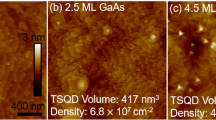Abstract
Electronic structure and optical transition characteristics in (100), (110), and (111) oriented InAs/GaAs quantum dots (containing \({\sim }2\) million atoms) were studied using a combination of valence force-field molecular mechanics and 20-band \(sp^{3}d^{5}s^{*}\) atomistic tight-binding framework. These quantum dots are promising candidates for non-traditional applications such as spintronics, quantum cryptography and quantum computation, but suffer from the deleterious effects of various internal fields. Here, the dependence of strain and polarization fields on the substrate orientation is reported and discussed. It is found that, compared to the (100) and (110) oriented counterparts, quantum dots grown on the (111) oriented substrate exhibit a smaller splitting (non-degeneracy) in the excited \(P\) states and enhanced isotropy in the interband optical emission characteristics.








Similar content being viewed by others
References
Juska, G., Dimastrodonato, V., Mereni, L.O., Gocalinska, A., Pelucchi, E.: Towards quantum-dot arrays of entangled photon emitters. Nat. Photonics 7, 527–531 (2013)
Rastelli, A., Kiravittaya, S., Schmidt, O.G.: Growth and control of optically active quantum dots. In: Michler, Peter (ed.) Single Semiconductor Quantum Dots. Springer, Berlin (2009)
Bimberg, D., Stock, E., Lochmann, A., Schliwa, A., Tofflinger, J.A., Unrau, W., Munnix, M., Rodt, S., Haisler, V.A., Toropov, A.I., Bakarov, A., Kalagin, A.K.: Quantum dots for single- and entangled-photon emitters. IEEE Photonics J. 1(1), 58–68 (2009)
Kuroda, T., Mano, T., Ha, N., Nakajima, H., Kumano, H., Urbaszek, B., Jo, M., Abbarachi, M., Sakuma, Y., Sakoda, K., Suemune, I., Marie, X., Amand, T.: Symmetric quantum dots as efficient sources of highly entangled photons. Phys. Rev. B 88, 041306(R) (2013)
Klimeck, G., Ahmed, S., Kharche, N., Bae, H., Clark, S., Haley, B., Lee, S., Naumov, M., Ryu, H., Saied, F., Prada, M., Korkusinski, M., Boykin, T.B.: Atomistic simulation of realistically sized nanodevices using NEMO 3-D. IEEE Trans. Electron Devices 54(9), 2079–2099 (2007)
Benson, O., Santori, C., Pelton, M., Yamamoto, Y.: Regulated and entangled photons from a single quantum dot. Phys. Rev. Lett. 84, 2513 (2000)
Grundmann, M., Stier, O., Bimberg, D.: InAs/GaAs pyramidal quantum dots: strain distribution, optical phonons, and electronic structure. Phys. Rev. B 52, 11969 (1995)
Wang, L.W., Kim, J., Zunger, A.: Electronic structures of (110)-faceted self-assembled pyramidal InAs/GaAs quantum dots. Phys. Rev. B 59, 5678 (1999)
Marquardt, O., O’Reilly, E.P., Schulz, S.: Electronic properties of site-controlled (111)-oriented zinc-blende InGaAs/GaAs quantum dots calculated using a symmetry-adapted \(\text{ k }\cdot \text{ p }\) Hamiltonian. J. Phys. 26, 035303 (2014)
Ahmed, S., Kharche, N., Rahman, R., Usman, M., Lee, S., Ryu, H., Bae, H., Clark, S., Haley, B., Naumov, M., Saied, F., Korkusinski, M., Kennel, R., Mclennan, M., Boykin, T.B., Klimeck, G.: Multimillion atom simulations with NEMO 3-D. In: Meyers, Robert (ed.) Encyclopedia of Complexity and Systems Science, vol. 6, pp. 5745–5783. Springer, New York (2009)
Boykin, T.B., Klimeck, G., Bowen, R.C., Oyafuso, F.: Diagonal parameter shifts due to nearest-neighbor displacements in empirical tight-binding theory. Phys. Rev. B 66, 125207 (2002)
Klimeck, G., Oyafuso, F., Boykin, T.B., Bowen, R.C., von Allmen, P.: Development of a nanoelectronic 3-D (NEMO 3-D) simulator for multimillion atom simulations and its application to alloyed quantum dots. J. Comput. Model. Eng. Sci. 3, 601 (2002)
Graf, M., Vogl, P.: Electromagnetic fields and dielectric response in empirical tight-binding theory. Phys. Rev. B 51, 4940 (1995)
Boykin, T.B., Bowen, R.C., Klimeck, G.: Electromagnetic coupling and gauge invariance in the empirical tight-binding method. Phys. Rev. B 63, 245314 (2001)
Boykin, T.B., Vogl, P.: Dielectric response of molecules in empirical tight-binding theory. Phys. Rev. B 65, 035202 (2001)
Bester, G., Zunger, A.: Cylindrically shaped zinc-blende semiconductor quantum dots do not have cylindrical symmetry: atomistic symmetry, atomic relaxation, and piezoelectric effects. Phys. Rev. B 71, 045318 (2005)
Bester, G., Zunger, A., Wu, X., Vanderbilt, D.: Effects of linear and nonlinear piezoelectricity on the electronic properties of InAs/GaAs quantum dots. Phys. Rev. B 74, 081305 (2006)
Ahmed, S., Islam, S., Mohammed, S.: Electronic structure of InN/GaN quantum dots: multimillion atom tight-binding simulations. IEEE Trans. Electron Devices 57(1), 164–173 (2010)
Yalavarthi, K., Chimalgi, V., Ahmed, S.: How important is nonlinear piezoelectricity in wurtzite GaN/InN/GaN disk-in-nanowire LED structures? Opt. Quant. Electron. 46, 925–933 (2014)
Sundaresan, S., Gaddipati, V., Ahmed, S.: Effects of spontaneous and piezoelectric polarization fields on the electronic and optical properties in GaN/AlN quantum dots: multimillion-atom \(\text{ sp }^{3}\text{ d }^{5}\text{ s }^{\ast }\) tight-binding simulations. Int. J. Numer. Model. doi:10.1002/jnm.2008
Acknowledgments
This work was supported by U.S. National Science Foundation Grant No. 1102192. Computational resources on https://nanoHUB.org were used for part of this work.
Author information
Authors and Affiliations
Corresponding author
Rights and permissions
About this article
Cite this article
Chimalgi, V., Kharche, N. & Ahmed, S. Effects of substrate orientation on opto-electronic properties in self-assembled InAs/GaAs quantum dots. J Comput Electron 13, 1026–1032 (2014). https://doi.org/10.1007/s10825-014-0626-4
Published:
Issue Date:
DOI: https://doi.org/10.1007/s10825-014-0626-4




